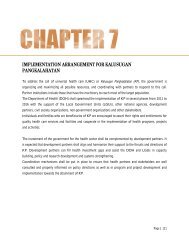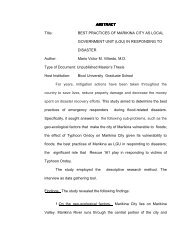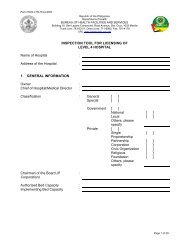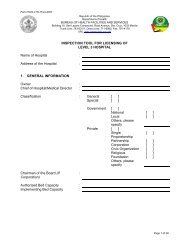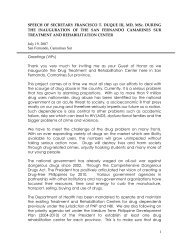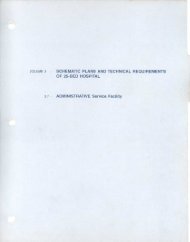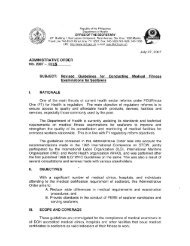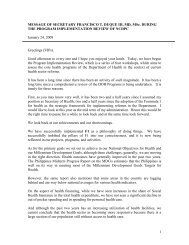Procedure for the procurement of consulting service - DOH
Procedure for the procurement of consulting service - DOH
Procedure for the procurement of consulting service - DOH
Create successful ePaper yourself
Turn your PDF publications into a flip-book with our unique Google optimized e-Paper software.
<strong>DOH</strong> CUSTOMIZED PROCUREMENT MANUAL VOLUME 4 2010<br />
What are <strong>the</strong> different types <strong>of</strong> consultancy contracts based on payment terms normally used?<br />
1. LUMP SUM CONTRACT<br />
Lump sum contracts are used mainly <strong>for</strong> assignments in which <strong>the</strong> content and <strong>the</strong> duration <strong>of</strong> <strong>the</strong><br />
<strong>service</strong>s and <strong>the</strong> required output <strong>of</strong> <strong>the</strong> consultants are clearly defined. They are widely used <strong>for</strong><br />
simple planning and feasibility studies, environmental studies, detailed design <strong>of</strong> standard or<br />
common structures, preparation <strong>of</strong> data processing systems, and so <strong>for</strong>th. Payments are linked to<br />
outputs (deliverables), such as reports, drawings, and bills <strong>of</strong> quantities, bidding documents, and<br />
s<strong>of</strong>tware programs. Lump sum contracts are easy to administer because payments are due on<br />
clearly specified outputs.<br />
2. TIME-BASED CONTRACT<br />
This type <strong>of</strong> contract is appropriate when it is difficult to define <strong>the</strong> scope and <strong>the</strong> length <strong>of</strong> <strong>the</strong><br />
<strong>service</strong>s, ei<strong>the</strong>r because <strong>the</strong> <strong>service</strong>s are related to activities by o<strong>the</strong>rs <strong>for</strong> which <strong>the</strong> completion<br />
period may vary, or because <strong>the</strong> input <strong>of</strong> <strong>the</strong> consultants required attaining <strong>the</strong> objectives <strong>of</strong> <strong>the</strong><br />
assignment is difficult to assess. This type <strong>of</strong> contract is widely used <strong>for</strong> complex studies,<br />
supervision <strong>of</strong> construction, advisory <strong>service</strong>s, and most training assignments. Payments are<br />
based on agreed hourly, daily, weekly or monthly rates <strong>for</strong> staff (who are normally named in <strong>the</strong><br />
contract) and on reimbursable items using actual expenses and/or agreed unit prices. The rates <strong>for</strong><br />
staff include salary, social costs, overhead, fee (or pr<strong>of</strong>it), and, where appropriate, special<br />
allowances. This type <strong>of</strong> contract should include a maximum amount <strong>of</strong> total payments to be made<br />
to <strong>the</strong> consultants. This ceiling amount should include a contingency allowance <strong>for</strong> un<strong>for</strong>eseen<br />
work and duration, and provision <strong>for</strong> price adjustments, where appropriate. Time-based contracts<br />
need to be closely monitored and administered by <strong>the</strong> client to ensure that <strong>the</strong> assignment is<br />
progressing satisfactorily and that payments claimed by <strong>the</strong> consultants are appropriate.<br />
3. RETAINER AND/OR CONTINGENCY (SUCCESS) FEE CONTRACT<br />
Retainer and contingency fee contracts are widely used when consultants are preparing<br />
companies <strong>for</strong> sales or mergers <strong>of</strong> firms, notably in privatization operations. The remuneration <strong>of</strong><br />
<strong>the</strong> consultant includes a retainer and a success fee, <strong>the</strong> latter being normally expressed as a<br />
percentage <strong>of</strong> <strong>the</strong> sale price <strong>of</strong> <strong>the</strong> assets.<br />
4. PERCENTAGE CONTRACT<br />
These contracts are commonly used <strong>for</strong> architectural <strong>service</strong>s. They may be also used <strong>for</strong><br />
<strong>procurement</strong> and inspection agents. Percentage contracts directly relate <strong>the</strong> fees paid to <strong>the</strong><br />
consultant to <strong>the</strong> estimated or actual project construction cost, or <strong>the</strong> cost <strong>of</strong> <strong>the</strong> goods procured or<br />
inspected. The contracts are negotiated on <strong>the</strong> basis <strong>of</strong> market norms <strong>for</strong> <strong>the</strong> <strong>service</strong>s and/or<br />
estimated staff-month costs <strong>for</strong> <strong>the</strong> <strong>service</strong>s, or competitively bid. It should be borne in mind that in<br />
<strong>the</strong> case <strong>of</strong> architectural or engineering <strong>service</strong>s, percentage contracts implicitly lack incentive <strong>for</strong><br />
economic design and are hence discouraged. There<strong>for</strong>e, <strong>the</strong> use <strong>of</strong> such a contract <strong>for</strong><br />
architectural <strong>service</strong>s is recommended only if it is based on a fixed target cost and covers precisely<br />
defined <strong>service</strong>s (<strong>for</strong> example, not works supervision).<br />
117



